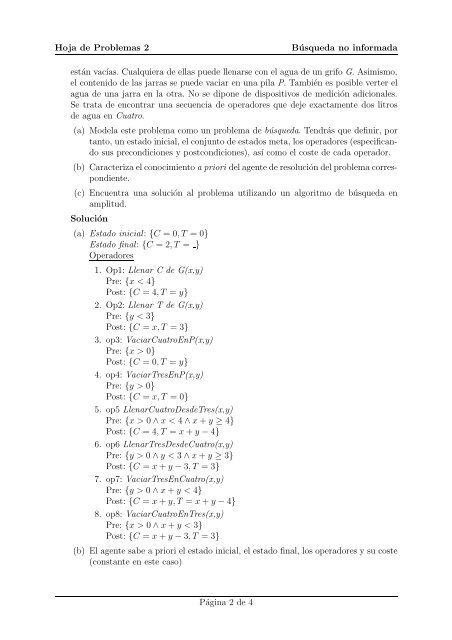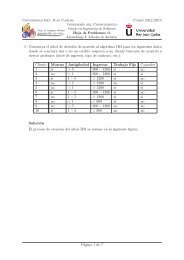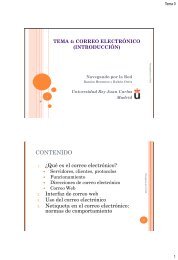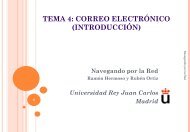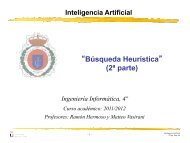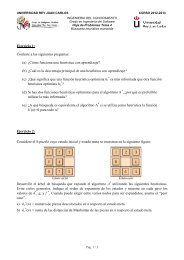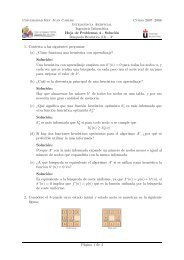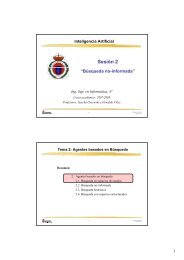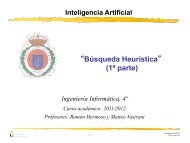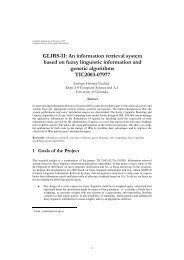1. Cuál o cuáles de las siguientes afirmaciones a - Grupo de ...
1. Cuál o cuáles de las siguientes afirmaciones a - Grupo de ...
1. Cuál o cuáles de las siguientes afirmaciones a - Grupo de ...
You also want an ePaper? Increase the reach of your titles
YUMPU automatically turns print PDFs into web optimized ePapers that Google loves.
Hoja <strong>de</strong> Problemas 2 Búsqueda no informada<br />
están vacías. Cualquiera <strong>de</strong> el<strong>las</strong> pue<strong>de</strong> llenarse con el agua <strong>de</strong> un grifo G. Asimismo,<br />
el contenido <strong>de</strong> <strong>las</strong> jarras se pue<strong>de</strong> vaciar en una pila P. También es posible verter el<br />
agua <strong>de</strong> una jarra en la otra. No se dipone <strong>de</strong> dispositivos <strong>de</strong> medición adicionales.<br />
Se trata <strong>de</strong> encontrar una secuencia <strong>de</strong> operadores que <strong>de</strong>je exactamente dos litros<br />
<strong>de</strong> agua en Cuatro.<br />
(a) Mo<strong>de</strong>la este problema como un problema <strong>de</strong> búsqueda. Tendrás que <strong>de</strong>finir, por<br />
tanto, un estado inicial, el conjunto <strong>de</strong> estados meta, los operadores (especificando<br />
sus precondiciones y postcondiciones), así como el coste <strong>de</strong> cada operador.<br />
(b) Caracteriza el conocimiento a priori <strong>de</strong>l agente <strong>de</strong> resolución <strong>de</strong>l problema correspondiente.<br />
(c) Encuentra una solución al problema utilizando un algoritmo <strong>de</strong> búsqueda en<br />
amplitud.<br />
Solución<br />
(a) Estado inicial: {C = 0, T = 0}<br />
Estado final: {C = 2, T = }<br />
Operadores<br />
<strong>1.</strong> Op1: Llenar C <strong>de</strong> G(x,y)<br />
Pre: {x < 4}<br />
Post: {C = 4, T = y}<br />
2. Op2: Llenar T <strong>de</strong> G(x,y)<br />
Pre: {y < 3}<br />
Post: {C = x, T = 3}<br />
3. op3: VaciarCuatroEnP(x,y)<br />
Pre: {x > 0}<br />
Post: {C = 0, T = y}<br />
4. op4: VaciarTresEnP(x,y)<br />
Pre: {y > 0}<br />
Post: {C = x, T = 0}<br />
5. op5 LlenarCuatroDes<strong>de</strong>Tres(x,y)<br />
Pre: {x > 0 ∧ x < 4 ∧ x + y ≥ 4}<br />
Post: {C = 4, T = x + y − 4}<br />
6. op6 LlenarTresDes<strong>de</strong>Cuatro(x,y)<br />
Pre: {y > 0 ∧ y < 3 ∧ x + y ≥ 3}<br />
Post: {C = x + y − 3, T = 3}<br />
7. op7: VaciarTresEnCuatro(x,y)<br />
Pre: {y > 0 ∧ x + y < 4}<br />
Post: {C = x + y, T = x + y − 4}<br />
8. op8: VaciarCuatroEnTres(x,y)<br />
Pre: {x > 0 ∧ x + y < 3}<br />
Post: {C = x + y − 3, T = 3}<br />
(b) El agente sabe a priori el estado inicial, el estado final, los operadores y su coste<br />
(constante en este caso)<br />
Página 2 <strong>de</strong> 4


